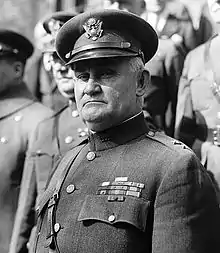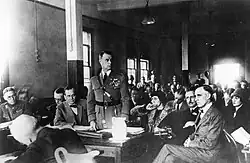Robert Lee Howze | |
|---|---|
 Howze as a major general | |
| Born | August 22, 1864 Overton, Texas, US |
| Died | September 19, 1926 (aged 62) Columbus, Ohio, US |
| Buried | 41.39896, −73.96729 |
| Allegiance | United States |
| Service/ | United States Army |
| Years of service | 1888–1926 |
| Rank | Major General |
| Commands held | 38th Division 3rd Division Third United States Army 1st Cavalry Division Fifth Corps Area |
| Battles/wars | Indian Wars Spanish–American War Philippine–American War World War I |
| Awards | Medal of Honor Army Distinguished Service Medal Silver Star (2) Legion of Honour (France) Croix de Guerre (France) |
| Relations | Major General Robert Lee Howze Jr. (son) General Hamilton H. Howze (son) |
Robert Lee Howze (August 22, 1864 – September 19, 1926) was a United States Army major general who was a recipient of the Medal of Honor for his actions during the American Indian Wars.
Howze graduated from the United States Military Academy in 1888 and then accepted a commission to the United States Army. He first served in the Indian Wars, then served in the Spanish–American War, Philippine–American War and World War I. His last assignment was presiding over the courts-martial of Colonel Billy Mitchell.
Early life

Howze was born to Captain James A. Howze, of the 14th Texas Cavalry, and Amanda Hamilton Howze in Overton, Rusk County, Texas. After graduating from Hubbard College in 1883,[1] he attended the United States Military Academy (USMA) at West Point, New York and was in the graduating class of 1888.[2] His classmates included several future general officers, such as Peyton C. March, William M. Morrow, James W. McAndrew, William Robert Dashiell, Peter Charles Harris, Eli Alva Helmick, Henry Jervey, William Voorhees Judson, John Louis Hayden, Edward Anderson, William H. Hart, Charles Aloysius Hedekin and William S. Peirce.
Military career
Howze participated in the Pine Ridge Campaign from November 1890 to January 1891. On January 1, 1891, the 6th Cavalry crossed the frozen White River in South Dakota to engage a group of Brulé Sioux. It was for this action he was presented with the Medal of Honor.[3][4]
Howze married Anne Chiffelle Hawkins, daughter of General Hamilton S. Hawkins and sister of General Hamilton S. Hawkins III, on February 24, 1897.[4]
At the outbreak of the Spanish–American War, Howze, now a cavalry captain, was made adjutant general of the cavalry in Cuba. Upon his return to the United States, he was appointed lieutenant colonel of volunteers and commanded the Thirty-fourth Volunteer Infantry throughout the Philippine Insurrection. He was promoted to captain in the United States Army on February 2, 1901; to brigadier general of volunteers on June 20, 1901; and to major of the Puerto Rico provincial regiment of infantry in 1901.[1] He received two Silver Citation Stars (converted in 1932 to the Silver Star decoration) for actions respectively in Cuba and the Philippines.

In 1905, Howze was appointed commandant of cadets at West Point, remaining in that post until 1909. In 1907 he threatened to discharge an entire class from the academy over a hazing incident.[5] Howze was a major in the 11th Cavalry during General John J. Pershing's Punitive Expedition into Mexico in 1916.[4]
During World War I Howze was promoted to major general and placed in command of the 38th Infantry Division, which fought in the Meuse-Argonne Offensive in October 1918. He served as commander of the 3rd Division during their march on the Rhine River, and commanded the Third Army of Occupation in Germany in 1919. He was awarded the Army Distinguished Service Medal, the French Croix de Guerre, and French Legion of Honor for his service in command of the Third Army.[4]
General Howze died while on active duty on September 19, 1926, at age 62,[6] and is buried in the United States Military Academy Cemetery at West Point, New York.
Court-martial of Billy Mitchell
Howze's last assignment was to preside over the court-martial of Colonel Billy Mitchell, who had made public comments in response to the Navy dirigible USS Shenandoah crashing in a storm.[7] The crash killed 14 of the crew and Mitchell issued a statement accusing senior leaders in the Army and Navy of incompetence and "almost treasonable administration of the national defense."[8] In November 1925 he was court-martialed at the direct order of President Calvin Coolidge. The trial attracted significant interest, and public opinion supported Mitchell.[9] The court found Mitchell guilty of insubordination, and suspended him from active duty for five years without pay.[10] The generals ruling in the case wrote, "The Court is thus lenient because of the military record of the Accused during the World War."[11] On February 1, 1926, Mitchell resigned in-lieu of accepting the courts punishment.[10]

Military awards
- Medal of Honor
- Distinguished Service Medal
- Silver Star with oak leaf cluster
- Indian Campaign Medal
- Spanish Campaign Medal
- Army of Cuban Occupation Medal
- Philippine Campaign Medal
- Mexican Border Service Medal
- Victory Medal
- Officer, French Legion of Honor
- French Croix de Guerre
Medal of Honor citation
Rank and organization: Second Lieutenant, Company K, 6th U.S. Cavalry. Place and date: At White River, S. Dak., 1 January 1891. Entered service at: Overton, Rusk County, Tex. Born: 22 August 1864, Overton, Rusk County, Tex. Date of issue: 25 July 1891.[3]
Citation:
Bravery in action.[2]
Army Distinguished Service Medal citation
Citation:
The President of the United States of America, authorized by Act of Congress, July 9, 1918, takes pleasure in presenting the Army Distinguished Service Medal to Major General Robert Lee Howze, United States Army, for exceptionally meritorious and distinguished services to the Government of the United States, in a duty of great responsibility during World War I. As Commander of the 3d Division on its march to the Rhine and during the occupation of the enemy territory General Howze proved himself energetic and capable, exhibiting superb qualities of leadership. He maintained an unusually high standard of efficiency in his unit, rendering eminently conspicuous service as a Division Commander.[2]
Dates of rank
| Insignia | Rank | Component | Date |
|---|---|---|---|
| None | Cadet | United States Military Academy | 1 July 1883 |
| None in 1888 | Second Lieutenant | Regular Army | 11 June 1888 |
| First Lieutenant | Regular Army | 9 January 1896 | |
| Captain | Volunteers | 12 May 1898 (Discharged from Volunteers on 31 December 1898.) | |
| Lieutenant Colonel | Volunteers | 5 July 1899 (Discharged from Volunteers 17 April 1901.) | |
| Captain | Regular Army | 2 February 1901 | |
| Brigadier General | Volunteer Army | 20 June 1901 (Discharged from Volunteers on 30 June 1901.) | |
| Major | Volunteers | 9 October 1901 (Discharged from Volunteers on 30 June 1904.) | |
| Major | Regular Army | 18 November 1911 | |
| Lieutenant Colonel | Regular Army | 1 July 1916 | |
| Colonel | Regular Army | 15 May 1917 | |
| Brigadier General | National Army | 6 February 1918 (Date of rank was 17 December 1917.) | |
| Major General | National Army | 8 August 1918 (Discharged 15 March 1920.) | |
| Brigadier General | Regular Army | 3 July 1920 | |
| Major General | Regular Army | 30 December 1922 |
Source: Army Register, 1926[12]
Namesakes
Camp Howze
There were two military installations named in honor of General Howze.
Camp Howze, Texas, was a large World War II training facility near Gainesville, Texas.[4]
Camp Howze, South Korea, was a US Army installation located off Main Supply Route (MSR) 1 near the towns of Kumchon and Paju-Ri.[13]
USS General R. L. Howze (AP-134)
The USS General R. L. Howze (AP-134), launched May 1943, was named in his honor.
Relations
Two of his sons graduated from the U.S. Military Academy at West Point and became generals: Major General Robert Lee Howze Jr., Class of 1925, and General Hamilton H. Howze, Class of 1930.[4]
See also
References
 This article incorporates public domain material from websites or documents of the United States Army Center of Military History.
This article incorporates public domain material from websites or documents of the United States Army Center of Military History.- Citations
- 1 2 "HOWZE, ROBERT LEE". Texas State Historical Association. Retrieved Dec 6, 2011.
- 1 2 3 "Robert Lee Howze". Hall of Valor. Military Times. Retrieved January 22, 2010.
- 1 2 "Medal of Honor recipients Indian Wars Period". Army Center of Military History. Archived from the original on November 10, 2010. Retrieved April 12, 2009.
- 1 2 3 4 5 6 "Robert Lee Howze". Texas State Cemetery. Retrieved April 12, 2009.
- ↑ "West Point CLASS MAY BE DISMISSED; Col. Howze Threatens to Discipline All the "Plebes" for Hazing. SILENT TREATMENT' GIVEN Bock of Illinois Complained of Sherman of Georgia and His Class Resented It". The New York Times. September 6, 1907. Retrieved April 12, 2009.
- ↑ Davis, Henry Blaine Jr. (1998). Generals in Khaki. Pentland Press, Inc. p. 190. ISBN 1571970886. OCLC 40298151
- ↑ Goldstein, Richard (December 18, 1998). "Gen. H.H. Howze, 89, Dies; Proposed Copters as Cavalry". The New York Times. Retrieved April 12, 2009.
- ↑ Tate, Dr. James P., Lt Col USAF, Retired (1998). The Army and Its Air Corps: Army Policy toward Aviation, 1919–1941. Air University Press.
{{cite book}}: CS1 maint: multiple names: authors list (link) - ↑ Maksel 2009, p. 48.
- 1 2 "Maxwell AFB. American Airpower Biography. Billy Mitchell". Archived from the original on 2008-09-24. Retrieved 2010-01-22.
- ↑ Maksel 2009, p. 49.
- ↑ The Adjutant General's Office, War Department (1926). Official Army Register for 1926 (PDF). Washington, D.C.: Government Printing Office. p. 296. Retrieved September 21, 2020.
- ↑ "Camp Howze". Globalsecurity.org. Retrieved January 10, 2014.
- Bibliography
Further reading
- Beyer, Walter Frederick; Keydel, Oscar Frederick, eds. (1906). Deeds of Valor Volume II. Detroit, Michigan: Perrien-Keydel. pp. 327–330. Retrieved April 13, 2009.
- Venzon, Anne Cipriano (2013). The United States in the First World War: an Encyclopedia. Hoboken, NJ: Taylor and Francis. ISBN 978-1-135-68453-2. OCLC 865332376.
External links
- Robert Lee Howze Jr. biography Archived 2006-05-19 at the Wayback Machine
- "Howze, Robert Lee". Handbook of Texas Online. Texas State Historical Association. Retrieved April 13, 2009.